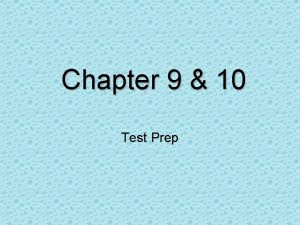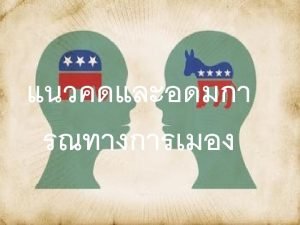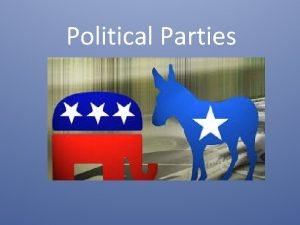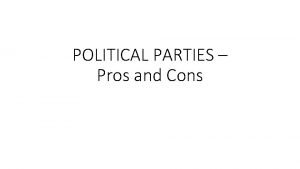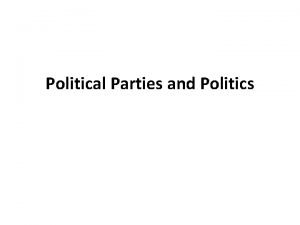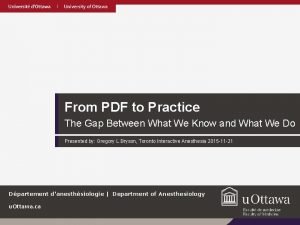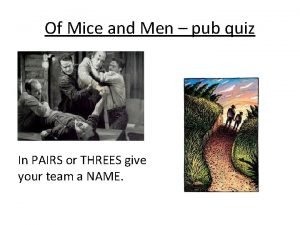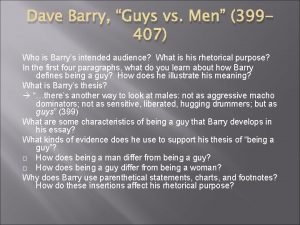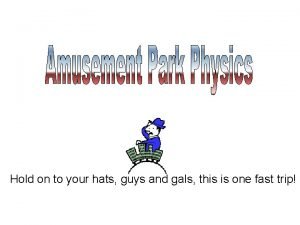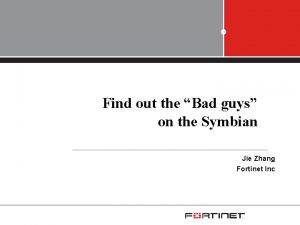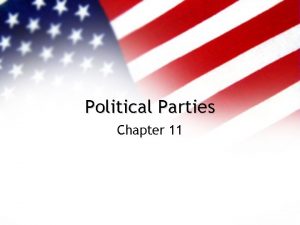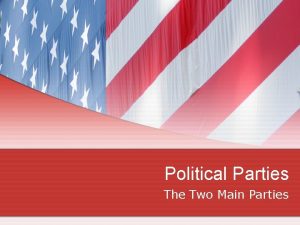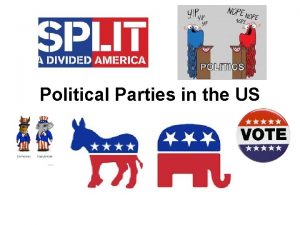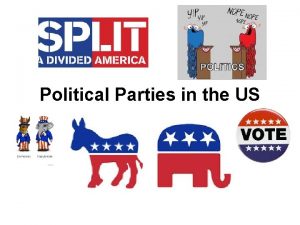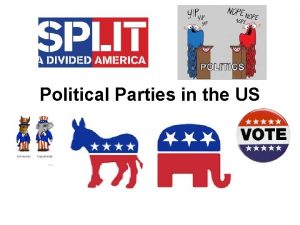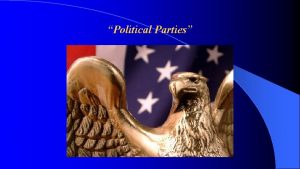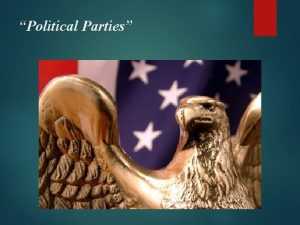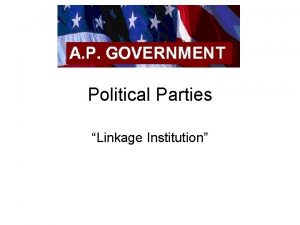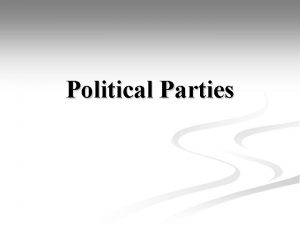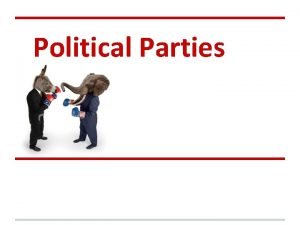Political Parties I mean it guys no parties














- Slides: 14

Political Parties “I mean it guys no parties while I am gone. ”

Roles of Political Parties • Party in the electorate – All of the people who associate themselves with one of the political parties. • Party in government – All of the appointed and elected officials at the national, state, and local levels who represent the party as members; office holders. • Party in organization – All of the people at various levels of the party organization who work to maintain the strength of the party between elections, help raise money, and organize the conventions and party functions.

One-Party System • One Party System – Only one party exists or has a chance of winning the election. Generally membership is not voluntary • Party leaders must approve candidates for the political office, and voters have no real choice. • The result is dictorial government • The Blue Wall conversation. • • What is the Blue Wall? How does it affect our election?

Two-Party System • There maybe several political parties but, only two major parties compete for power and dominate elections. • People are given “Either or” option simplifying the election process. • Tends to enhance governmental stability. • The Electoral college makes it difficult for third parties to win. • Third Party conversation. • • Can a third party win? How can a third party win?

Multi-Party System • This happens when several major parties and a number of minor parties compete in the same elections, and any party has a good chance of winning. • Often found in European Nations – Germany 1932, Italy 1908, and 1932, France 2008. • Idea is to give voters meaningful choices. • Tends to lend itself to more instability in government especially when a coalition is formed. • Dangers of Multi-Parties • • Do they accomplish what they set out to do? Does it last?

What do Political Parties Do? • Recruit candidates – Find Candidates interested in running for public office, especially if no incumbent is running. • Nominate and support candidates for office – They raise money and run candidate campaigns through party organization. • Educate the electorate – Inform voters about candidates and encourage voters to participate in the election. • Organize the government – The organization of Congress and state legislatures is based on political party controls (Majority vs. Minority Party); Political appointments are often made based on political party affiliation

Party Identification and Membership • Ideology • Education • Income – This is total Bull Crap! • Occupation • Race or Ethnicity • Gender • Religion • Family Tradition • Region of the Country • Marital Status

• • The Two-Party Tradition in America Why a two party system? • • Historical roots – Federalist vs. Anti-Federalist • Election Laws – Vary from state to state, which makes it difficult for minor parties to get on the ballot Electoral System – Single member districts mean that only one representative is chosen from each district Is there a Solution? • There is always a solution lets discuss them shall we: • • • More parties No parties More debates with more potential candidates No open primaries Voter laws that are across the board

Rise of Political Parties; Development from (1789 -Present) • Democratic Domination (1800 – 1860) - Andrew Jackson • • The “Common Man Party” Fought to end all suffrage to all white males • Republican Domination (1860 -1932) Abraham Lincoln • • “The Grand Ol’ Party” – The GOP Fought to end all suffrage to all people. • Return of the Democrats (1932 -1968) – Franklin Delano Roosevelt • • “The New Deal Coalition” Locked up the minority vote, the union workers, and the women’s vote

Rise of Political Parties; Development from (1789 -Present) • Divided Government (1968 – Present) - Ronald Reagan • • Division has created Gridlock General Election goes Democrat while off-year elections goes Republican • Electoral Dealignment – When a significant number of voters no longer support a particular party. Then dealignment occurs. Voter feels they owe no loyalty to any particular party • Electoral Realignment – When voting patterns shift and new coalitions of party supporters have formed.

Third or Minor Parties • Third Parties have not won many elections, they have forced the two major parties to reform significantly over the years • Success rather than failure often brings an end to minor or third parties • Types of Third-Parties • Ideological – Those based on a particular set of social, political, or economic beliefs (Communist, Socialist, Libertarian) • Splinter/personality/factional – Those that have split from one of the major parties; usually formed around strong personalities a prime example of this is Teddy Roosevelt’s Bull Moose Party (Progressive, States Rights, American Independent). • Single Issue – Parties that concentrate on a single public policy matter (Free Soil, Right to Life, Prohibition, Legalize Marijuana) • Protest – Usually rooted in periods of economic discontent; maybe sectional in nature (Black Lives Matters)

Structure and organization of Political Parties • A political party must have an effective organization to accomplish it’s goals. • There in lies the problem with third parties. • Here is a list of things a political party needs to be successful • • • National Convention – Serves as the parties voice • Congressional Campaign Committee - They determine which candidates to flood money to for their campaigns so they can win re-election. Often they will go after the candidate who has the best chance to win based on the oppositions weaker candidates. National Committee – Manages the parties business between conventions National Chairperson – The Chairperson is responsible for directing the work of the national committee from their headquarters in Washington D. C.

Structure and organization of Political Parties • State and Local Organization – State law largely determines state and local party organization. Differences do exist from state to state however, states are structured in much the same way as the national party organization. • Generally state parties are more organized and better funded thanks to soft money • Money that is donated but, does not have to be disclosed under Federal Election Campaign Act (1971) or its amendments. • In 2002 this was severely restricted by the Reform Act also known as the Mc. Cain-Feingold Act • Mc. Cain the Republican and Russ Fiengold ( Wisconsin) and Democrat went totally against the law and right in line with the Democrats who were pushing for this. • The Supreme Court ruled in, Citizens United v ECU (2010) that the Reform Act (A. K. A. Mc. Cain. Fiengold Act). They determined that Reform Act was Unconstitutional.

• • • Future of Political Parties Third – Party Challenges – In recent elections third-party challenges have taken votes from major candidates, lessening their ability to win a majority of the vote. Loss of support by party loyalist – The number of independent voters has increased. Increase in split-ticket voting – Many voters no longer vote straight ticket (Only for candidates of one political party) but rather split their vote among candidates from more than one party. Lack of perceived differences between the parties – Voters often believe there are no major differences in the parties of their candidates Party Reform – Changes within the parties themselves to create grater diversity and openness have allowed for greater conflict within some parties. Methods of campaigning – New technologies have allowed candidates to become more independent of parties and more directly involved with the voters.
 The spoils system made political parties more powerful by
The spoils system made political parties more powerful by Wikimedia
Wikimedia Political parties
Political parties Political parties
Political parties The supreme court change
The supreme court change Political parties pros and cons
Political parties pros and cons Win the white house brainpop
Win the white house brainpop A political party is an association of
A political party is an association of Endo guys ottawa
Endo guys ottawa Curley's like a lot of little guys
Curley's like a lot of little guys Veronika 50 guys
Veronika 50 guys Guys vs men dave barry
Guys vs men dave barry Hold on guys
Hold on guys Bad guys mdl
Bad guys mdl Hi guys how are you
Hi guys how are you
